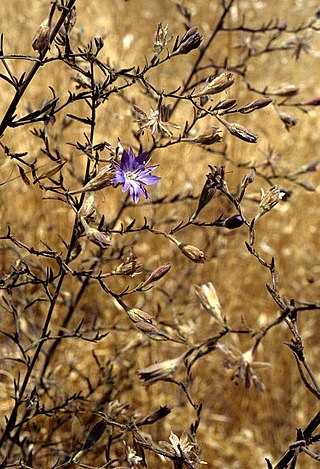
Alonsoa is a genus of 12 species of flowering plants in the family Scrophulariaceae. The genus includes both herbaceous and shrubby species.

Malesherbia is a genus of flowering plants consisting of 25 species in the Passifloraceae. This is a xerophytic group endemic to the Peruvian and Chilean deserts and adjacent Argentina. The genus is currently recognized by the APG III system of classification in the family Passifloraceae, and is the sole member of the subfamily Malesherbioideae.

Heliconia rostrata, the hanging lobster claw or false bird of paradise, is a herbaceous perennial plant native to El Salvador, Peru, Bolivia, Colombia, Venezuela, Costa Rica, and Ecuador, and naturalized in Puerto Rico. Other heliconias grow in an upright position, their cup-shaped flower bracts storing water for birds and insects. This plant, however, has downward-facing flowers, the flowers thus providing a source of nectar to birds.

Campomanesia is a genus in the family Myrtaceae described as a genus in 1794. It is native to South America and Trinidad.

Soliva is a genus of South American plants in the sunflower family. Burrweed is a common name for some species in this genus.

Hipólito Ruiz López, or Hipólito Ruiz, was a Spanish botanist known for researching the floras of Peru and Chile during an expedition under Carlos III from 1777 to 1788. During the reign of Carlos III, three major botanical expeditions were sent to the New World; Ruiz and José Antonio Pavón Jiménez were the botanists for the first of these expeditions, to Peru and Chile.

Galinsoga is a genus of flowering plants in the family Asteraceae. It is native to North and South America and the West Indies, and naturalized in Europe, Asia, Africa, and Australia.

Brunellia is a genus of trees. They are distributed in the mountainous regions of southern Mexico, Central America, West Indies, and South America. Brunellia is the only genus in the family Brunelliaceae. As of 2001 there were about 54 species.
Sessea is a genus of 19 accepted species of shrubs, small trees and climbers belonging to the subfamily Cestroideae of the plant family Solanaceae. The flowers of Sessea are so similar to those of Cestrum that the genera cannot usually be told apart, unless the plants are in fruit. Then their distinguishing characteristics become immediately apparent; plants of the genus Sessea bearing dehiscent capsules dispersing winged seeds, while those belonging to the genus Cestrum bear juicy berries containing prismatic seeds. The flowers of both Sessea and Cestrum have tubular corollas that are long exserted from small calyces.

José Antonio Pavón Jiménez or José Antonio Pavón was a Spanish botanist known for researching the flora of Peru and Chile.

Conanthera is a genus of small bulbous plants with small panicles of blue, purple or white and purple flowers. Propagation is by offsets or seed. All species are native to Chile, but there is an old 18th-Century report of C. bifolia occurring in colonial Peru as well. This could possibly be attributed to changes in boundaries between the two countries, as modern sources list the species as endemic to Chile.
- Conanthera bifoliaRuiz & Pav. - from Valparaíso to La Araucanía
- Conanthera campanulataLindl. - from Antofagasta to La Araucanía
- Conanthera parvula(Phil.) Muñoz-Schick - from Valparaíso to La Araucanía
- Conanthera trimaculata(D.Don) F.Meigen - central Chile
- Conanthera urceolataRavenna - Atacama

Tessaria is a genus of South American plants in the tribe Inuleae within the family Asteraceae.

Moscharia is a genus of flowering plants in the family Asteraceae native to South America. It has two recognized species.
Plazia is a genus of South American plants in the family Asteraceae.

Chaetanthera is a genus of South American flowering plants in the family Asteraceae.

Pineda is a genus of flowering plants in the family Salicaceae. It contains two species of shrubs: Pineda incana, which is native to the Andes of Ecuador and Peru, and Pineda ovata, which is native to the Andes of Bolivia.
The Botanical Expedition to the Viceroyalty of Peru was a Spanish expedition to the colonial territories of the Viceroyalty of Peru and Chile between 1777 and 1788.

Cosmibuena is a genus of flowering plants in the family Rubiaceae. The genus is native to Chiapas, Central America, and South America as far south as Brazil.

Mecardonia (axilflower) is a genus of herbaceous plants in the family Plantaginaceae. 31 species have been described, of which 12 are accepted. Its distribution is predominantly in South America, and South East United States, including Florida and Alabama but may be found as far north as Virginia. (see map) Five species are found in Argentina and three in the US.
Porcelia is a genus of flowering plants in the family Annonaceae containing at least 19 species of which all are native to Latin America.














